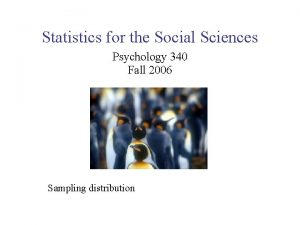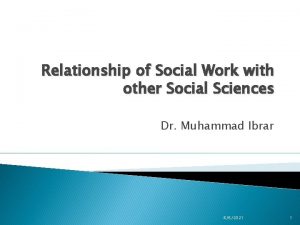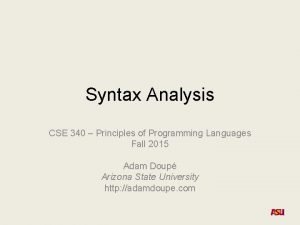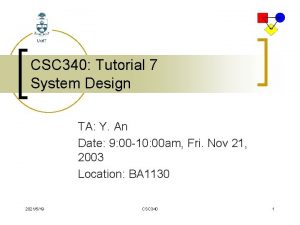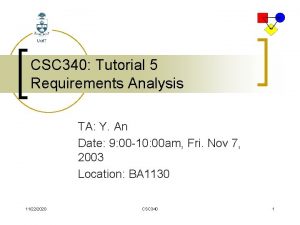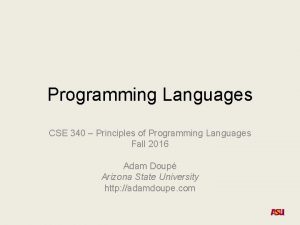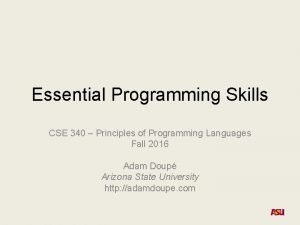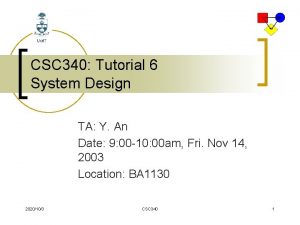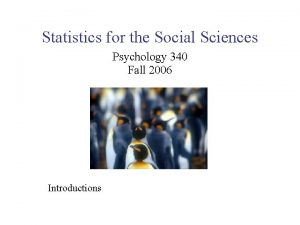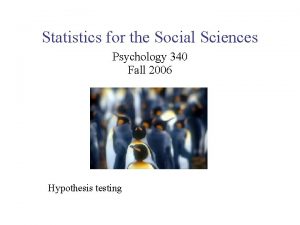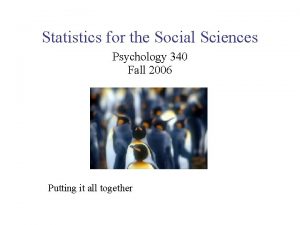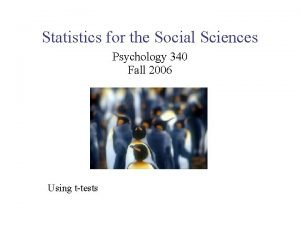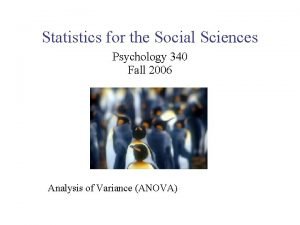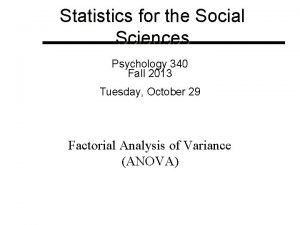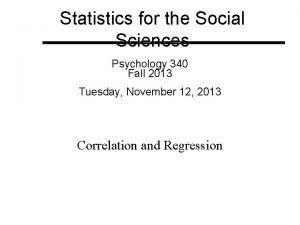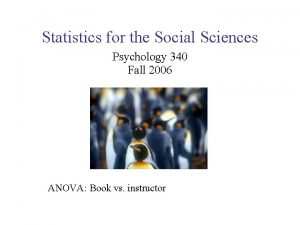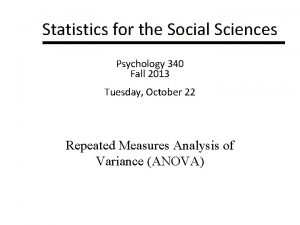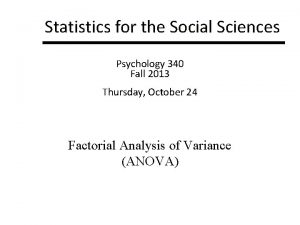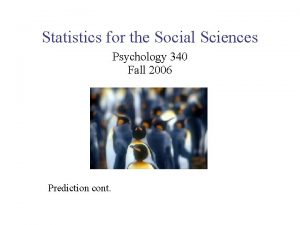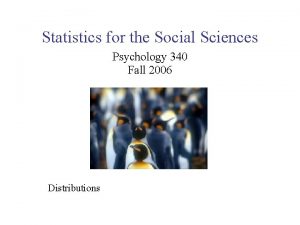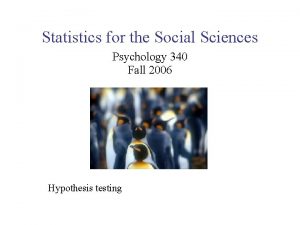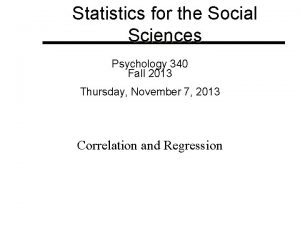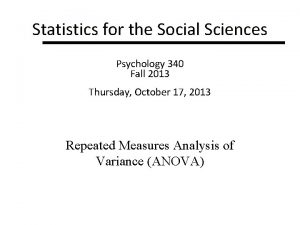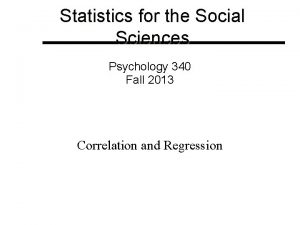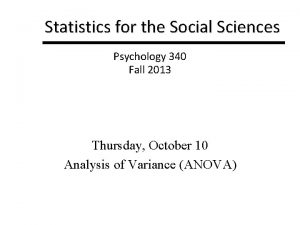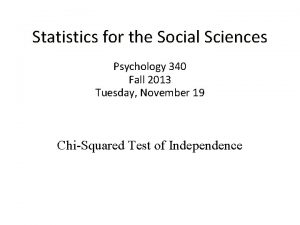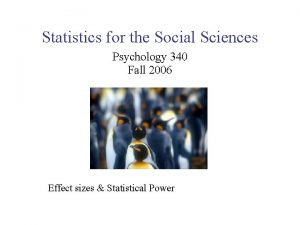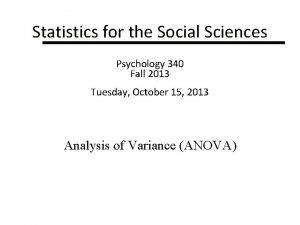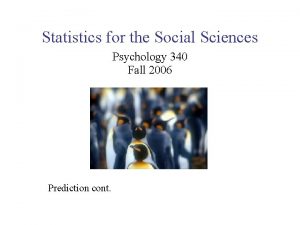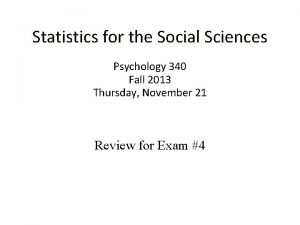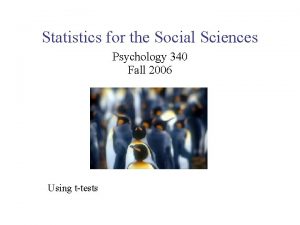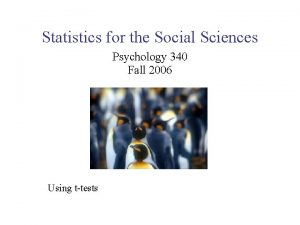Statistics for the Social Sciences Psychology 340 Fall
































- Slides: 32

Statistics for the Social Sciences Psychology 340 Fall 2006 Sampling distribution

Outline Statistics for the Social Sciences • Review 138 stuff: – – What are sample distributions Central limit theorem Standard error (and estimates of) Test statistic distributions as transformations

Testing Hypotheses Statistics for the Social Sciences • From last time: How do we determine this? – Core logic of hypothesis testing • Considers the probability that the result of a study could have come about if the experimental procedure had no effect – If this probability is low, scenario of no effect is rejected and theory behind the experimental procedure is supported Based on standard error or an estimate of the standard error

Flipping a coin example Statistics for the Social Sciences 2 n = 23 = 8 total outcomes HHH Number of heads 3 HHT 2 HTH 2 HTT 1 THH 2 THT 1 TTH 1 TTT 0

Flipping a coin example Statistics for the Social Sciences Number of heads 3 Distribution of possible outcomes probability (n = 3 flips) . 4. 3. 2. 1. 125. 375. 125 0 1 2 3 Number of heads 2 X f p 3 2 1 1 3 3 . 125. 375 2 0 1 . 125 1 1 2 1 0

Hypothesis testing Statistics for the Social Sciences Distribution of Sample Means Distribution of possible outcomes (of a particular sample size, n) Can make predictions about likelihood of outcomes based on this distribution. • In hypothesis testing, we compare our observed samples with the distribution of possible samples (transformed into standardized distributions) • This distribution of possible outcomes is often Normally Distributed

Hypothesis testing Statistics for the Social Sciences Distribution of Sample Means Distribution of possible outcomes • Mean of a group of scores (of a particular sample size, n) – Comparison distribution is distribution of means

Distribution of sample means Statistics for the Social Sciences • Distribution of sample means is a “theoretical” distribution between the sample and population • Mean of a group of scores – Comparison distribution is distribution of means Population Distribution of sample means Sample

Distribution of sample means Statistics for the Social Sciences • A simple case – Population: 2 4 6 8 – All possible samples of size n = 2 Assumption: sampling with replacement

Distribution of sample means Statistics for the Social Sciences • A simpler case – Population: 2 4 6 8 – All possible samples of size n = 2 mean 2 2 4 6 2 5 2 4 4 8 6 3 2 6 6 2 4 4 2 8 6 4 5 5 4 2 6 6 3 6 4 4 6 8 4 7 There are 16 of them mean 8 2 5 8 4 6 8 6 7 8 8 8

Distribution of sample means Statistics for the Social Sciences 5 4 3 2 1 In long run, the random selection of tiles leads to a predictable pattern 2 3 4 5 6 7 8 means 2 mean 2 2 4 6 2 4 4 8 2 6 6 2 2 8 6 4 4 2 6 6 4 4 6 8 3 4 5 3 4 mean 5 6 4 5 6 7 8 2 8 4 8 6 8 8 mean 5 6 7 8

Distribution of sample means Statistics for the Social Sciences • Sample problem: 5 4 3 2 1 2 3 4 5 6 7 8 means X f – What’s the probability of getting a sample with a mean of 6 or more? p 8 1 0. 0625 7 2 0. 1250 6 3 0. 1875 5 4 0. 2500 4 3 0. 1875 3 2 0. 1250 2 1 0. 0625 P(X > 6) =. 1875 +. 1250 +. 0625 = 0. 375 • Same as before, except now we’re asking about sample means rather than single scores

Statistics for the Social Sciences Properties of the distribution of sample means • Shape – If population is Normal, then the dist of sample means will be Normal – If the sample size is large (n > 30), regardless of shape of the population Population Distribution of sample means N > 30

Statistics for the Social Sciences Properties of the distribution of sample means • Center – The mean of the dist of sample means is equal to the mean of the population Population Distribution of sample means same numeric value different conceptual values

Statistics for the Social Sciences Properties of the distribution of sample means • Center – The mean of the dist of sample means is equal to the mean of the population – Consider our earlier example Population 2 4 6 Distribution of sample means 8 = 2+4+6+8 4 =5 5 4 3 2 1 2 3 4 5 6 7 8 means = 2+3+4+5+6+4+5+6+7+8 16 =5

Statistics for the Social Sciences Properties of the distribution of sample means • Spread – The standard deviation of the distribution of sample mean depends on two things • Standard deviation of the population • Sample size

Statistics for the Social Sciences Properties of the distribution of sample means • Spread • Standard deviation of the population • The smaller the population variability, the closer the sample means are to the population mean X 3 X 1 X 2

Statistics for the Social Sciences Properties of the distribution of sample means • Spread • Sample size n=1 X

Statistics for the Social Sciences Properties of the distribution of sample means • Spread • Sample size n = 10 X

Statistics for the Social Sciences Properties of the distribution of sample means • Spread • Sample size n = 100 The larger the sample size the smaller the spread X

Statistics for the Social Sciences Properties of the distribution of sample means • Spread • Standard deviation of the population • Sample size – Putting them together we get the standard deviation of the distribution of sample means – Commonly called the standard error

Standard error Statistics for the Social Sciences • The standard error is the average amount that you’d expect a sample (of size n) to deviate from the population mean – In other words, it is an estimate of the error that you’d expect by chance (or by sampling)

Distribution of sample means Statistics for the Social Sciences • Keep your distributions straight by taking care with your notation Population Distribution of sample means Sample s X

Statistics for the Social Sciences Properties of the distribution of sample means • All three of these properties are combined to form the Central Limit Theorem – For any population with mean and standard deviation , the distribution of sample means for sample size n will approach a normal distribution with a mean of and a standard deviation of as n approaches infinity (good approximation if n > 30).

Performing your statistical test Statistics for the Social Sciences • What are we doing when we test the hypotheses? – Computing a test statistic: Generic test Could be difference between a sample and a population, or between different samples Based on standard error or an estimate of the standard error

Statistics for the Social Sciences Hypothesis Testing With a Distribution of Means • It is the comparison distribution when a sample has more than one individual • Find a Z score of your sample’s mean on a distribution of means

“Generic” statistical test Statistics for the Social Sciences An example: One sample z-test Memory example experiment: • We give a n = 16 memory patients a memory improvement treatment. • After the treatment they have an average score of = 55 memory errors. • How do they compare to the general population of memory patients who have a distribution of memory errors that is Normal, = 60, = 8? • Step 1: State your hypotheses H 0: the memory treatment sample are the same (or worse) as the population of memory patients. Treatment > pop > 60 HA: Their memory is better than the population of memory patients Treatment < pop < 60

“Generic” statistical test Statistics for the Social Sciences An example: One sample z-test H 0: Treatment > pop > 60 HA: Treatment < pop < 60 Memory example experiment: • We give a n = 16 memory patients a memory improvement treatment. • After the treatment they have an average score of = 55 memory errors. • How do they compare to the general population of memory patients who have a distribution of memory errors that is Normal, = 60, = 8? • Step 2: Set your decision criteria a = 0. 05 One -tailed

“Generic” statistical test Statistics for the Social Sciences An example: One sample z-test H 0: Treatment > pop > 60 HA: Treatment < pop < 60 Memory example experiment: • We give a n = 16 memory patients a memory improvement treatment. • After the treatment they have an average score of = 55 memory errors. • How do they compare to the general population of memory patients who have a distribution of memory errors that is Normal, = 60, = 8? One -tailed • a = 0. 05 Step 3: Collect your data

“Generic” statistical test Statistics for the Social Sciences An example: One sample z-test H 0: Treatment > pop > 60 HA: Treatment < pop < 60 Memory example experiment: • We give a n = 16 memory patients a memory improvement treatment. • After the treatment they have an average score of = 55 memory errors. • How do they compare to the general population of memory patients who have a distribution of memory errors that is Normal, = 60, = 8? One -tailed • a = 0. 05 Step 4: Compute your test statistics = -2. 5

“Generic” statistical test Statistics for the Social Sciences An example: One sample z-test Memory example experiment: • We give a n = 16 memory patients a memory improvement treatment. H 0: Treatment > pop > 60 HA: Treatment < pop < 60 One -tailed a = 0. 05 • Step 5: Make a decision about • After the treatment they have an your null hypothesis average score of = 55 memory errors. • How do they compare to the general population of memory patients who have 5% a distribution of memory errors that is Normal, = 60, = 8? Reject H 0

“Generic” statistical test Statistics for the Social Sciences An example: One sample z-test Memory example experiment: • We give a n = 16 memory patients a memory improvement treatment. • • After the treatment they have an average score of = 55 memory errors. • How do they compare to the general population of memory patients who have a distribution of memory errors that is Normal, = 60, = 8? H 0: Treatment > pop > 60 HA: Treatment < pop < 60 One -tailed a = 0. 05 Step 5: Make a decision about your null hypothesis - Reject H 0 - Support for our HA, the evidence suggests that the treatment decreases the number of memory errors
 Statistics for social sciences
Statistics for social sciences Natural science tok
Natural science tok Relation of social work with other social sciences
Relation of social work with other social sciences Multivariate statistics for the environmental sciences
Multivariate statistics for the environmental sciences Chapter 13 social psychology
Chapter 13 social psychology Social psychology ap psychology
Social psychology ap psychology Social psychology is the scientific study of
Social psychology is the scientific study of Social thinking and social influence in psychology
Social thinking and social influence in psychology Social thinking adalah
Social thinking adalah Introduction to statistics what is statistics
Introduction to statistics what is statistics Oba-340
Oba-340 Viksund 340 st cruz flybridge
Viksund 340 st cruz flybridge 2,340,000,000
2,340,000,000 2,340,000,000
2,340,000,000 Mgt 340 assignment
Mgt 340 assignment Mos capacitor c-v curve
Mos capacitor c-v curve Crime de denunciação caluniosa
Crime de denunciação caluniosa Szkoła podstawowa nr 340 warszawa
Szkoła podstawowa nr 340 warszawa Cse 340 asu
Cse 340 asu Adam doupe cse 340
Adam doupe cse 340 Ece 340
Ece 340 Qualitative description of current flow at a junction
Qualitative description of current flow at a junction Cse 340 project 1
Cse 340 project 1 System design tutorial
System design tutorial Csc 340
Csc 340 Oba-340
Oba-340 Oba-340
Oba-340 Vineeth kashyap
Vineeth kashyap Old ucas points
Old ucas points Adam doupe cse 340
Adam doupe cse 340 3253/340
3253/340 Adam doupe cse 340
Adam doupe cse 340 Csc 340
Csc 340
